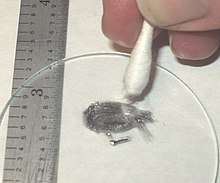Galinstan
Galinstan is a brand-name and a common name for any member of a family of liquid metal eutectic alloys whose composition is mainly consisting of gallium, indium, and tin. Such eutectic alloys are liquids at room temperature, typically melting at +11 °C (52 °F), while commercial Galinstan melts at −19 °C (−2 °F).[1]
Galinstan is composed of 68.5% Ga, 21.5% In, and 10.0% Sn (by weight).[2]
Due to the low toxicity and low reactivity of its component metals, galinstan finds use as a replacement for many applications that previously employed the toxic liquid mercury or the reactive NaK (sodium–potassium alloy).
Name
The name “Galinstan” is a portmanteau of gallium, indium, and stannum (Latin for “tin”).
The brand-name “Galinstan” is a registered trademark of the German company Geratherm Medical AG, but “galinstan” is in common use for any eutectic alloy of gallium, indium, and tin.
Physical properties

- Boiling point: > 1300 °C
- Melting point: −19 °C[3]
- Vapour pressure: < 10−8 Torr (at 500 °C)
- Density: 6.44 g/cm3 (at 20 °C)[4]
- Solubility: Insoluble in water or organic solvents
- Viscosity: 0.0024 Pa·s (at 20 °C)
- Thermal conductivity: 16.5 W·m−1·K−1
- Electrical conductivity: 3.46×106 S/m (at 20 °C)[4]
- Surface tension: s = 0.535 - 0.718 N/m (at 20 °C, dependent on producer)[5][6][7]
- Specific heat capacity: 296 J·kg−1·K−1[8]
Galinstan tends to be “wet” and adhere to many materials, including glass, which limits its use compared to mercury.
Uses
Galinstan is commercially used as a mercury replacement in thermometers due to its nontoxic properties, but the inner tube surface must be coated with gallium oxide to prevent the alloy from wetting the glass surface.
Galinstan has higher reflectivity and lower density than mercury. In the field of astronomy it is considered as a replacement for mercury in liquid-mirror telescopes.[9]
Galinstan may be used as a thermal interface for computer hardware cooling solutions, though major obstacles for widespread use are its cost and aggressive corrosive properties (it corrodes many other metals such as aluminium by dissolving them). It is also electrically conductive, and so needs to be applied more carefully than regular non-conductive compounds. Two thermal interfaces have already been developed: Thermal Grizzly Conductonaut and Coolaboratory Liquid Ultra, with thermal conductivities of 73 and 38.4 W/mK respectively.[10][11] However, they must be carefully applied with a Q-tip (unlike ordinary thermal compounds, where no manual spreading is needed), and cannot be used on aluminum heatsinks as aforementioned.
Galinstan is difficult to use for cooling fission-based nuclear reactors, because indium has a high absorption cross section for thermal neutrons, efficiently absorbing them and inhibiting the fission reaction. Conversely, it is being investigated as a possible coolant for fusion reactors. Unlike other liquid metals used in this application, such as lithium and mercury, the nonreactivity makes galinstan a safer material to use.[12]
X-ray equipment
Extremely high-intensity sources of 9.25 keV X-rays (gallium K-alpha line) for X-ray phase microscopy of fixed tissue (such as mouse brain), from a focal spot about 10 μm × 10 μm, and 3-D voxels of about one cubic micrometer, may be obtained with an X-ray source that uses a liquid-metal galinstan anode.[13] The metal flows from a nozzle downward at a high speed, and the high-intensity electron source is focused upon it. The rapid flow of metal carries current, but the physical flow prevents a great deal of anode heating (due to forced-convective heat removal), and the high boiling point of galinstan inhibits vaporization of the anode.[14]
See also
References
- Surmann, P; Zeyat, H (Nov 2005). "Voltammetric analysis using a self-renewable non-mercury electrode". Analytical and Bioanalytical Chemistry. 383 (6): 1009–1013. doi:10.1007/s00216-005-0069-7. PMID 16228199.
- Liu, Jing (2018-07-14). "Ch 5 Preparations and Characterizations of Functional Liquid Metal Materials". Liquid metal biomaterials : principles and applications. Yi, Liting. Singapore. p. 96. ISBN 9789811056079. OCLC 1044746336.
- ZHANG (2019). "Characterization of Triboelectric Nanogenerators". Flexible and stretchable triboelectric nanogenerator devices - toward self-powered ... systems. WILEY. p. 70. ISBN 978-3527345724. OCLC 1031449827.
- "Experimental Investigations of Electromagnetic Instabilities of Free Surfaces in a Liquid Metal Drop" (PDF). International Scientific Colloquium Modelling for Electromagnetic Processing, Hannover. March 24–26, 2003. Retrieved 2009-08-08.
- Liu, Tingyi (April 2012). "Characterization of Nontoxic Liquid-Metal Alloy Galinstan for Applications in Microdevices". Journal of Microelectromechanical Systems. 21 (2): 448. CiteSeerX 10.1.1.703.4444. doi:10.1109/JMEMS.2011.2174421.
- Jeong, Seung Hee; Hagman, Anton; Hjort, Klas; Jobs, Magnus; Sundqvist, Johan; Wu, Zhigang (2012). "Liquid alloy printing of microfluidic stretchable electronics". Lab on a Chip. 12 (22): 4657–64. doi:10.1039/c2lc40628d. ISSN 1473-0197. PMID 23038427.
- Handschuh-Wang, Stephan; Chen, Yuzhen; Zhu, Lifei; Zhou, Xuechang (2018-06-20). "Analysis and Transformations of Room-Temperature Liquid Metal Interfaces - A Closer Look through Interfacial Tension". ChemPhysChem. 19 (13): 1584–1592. doi:10.1002/cphc.201800559. ISSN 1439-4235.
- Hodes, Marc; Zhang, Rui; Steigerwalt Lam, Lisa; Wilcoxon, Ross; Lower, Nate (2014). "On the Potential of Galinstan-Based Minichannel and Minigap Cooling". IEEE Transactions on Components, Packaging and Manufacturing Technology. 4 (1): 46–56. doi:10.1109/tcpmt.2013.2274699. ISSN 2156-3950.
- Minerals Yearbook Metals and Minerals 2010 Volume I. Government Printing Office. 2010. p. 48.4. Extract of page 48.4
- "Thermal Grizzly High Performance Cooling Solutions - Conductonaut". Thermal Grizzly. Retrieved 2019-12-18.
- Wallossek 2013-10-21T06:00:01Z, Igor. "Thermal Paste Comparison, Part Two: 39 Products Get Tested". Tom's Hardware. Retrieved 2019-12-18.
- Lee C. Cadwallader (2003). "Gallium Safety in the Laboratory" (preprint). Cite journal requires
|journal=(help) - Hemberg, O.; Otendal, M.; Hertz, H. M. (2003). "Liquid-metal-jet anode electron-impact x-ray source". Appl. Phys. Lett. 83: 1483. doi:10.1063/1.1602157.
- Töpperwien, M.; et al. (2017). "Three-dimensional mouse brain cytoarchitecture revealed by laboratory-based x-ray phase-contrast tomography". Sci. Rep. 7: 42847. doi:10.1038/srep42847.
- Scharmann, F.; Cherkashinin, G.; Breternitz, V.; Knedlik, Ch.; Hartung, G.; Weber, Th.; Schaefer, J. A. (2004). "Viscosity effect on GaInSn studied by XPS". Surface and Interface Analysis. 36 (8): 981. doi:10.1002/sia.1817.
- Dickey, Michael D.; Chiechi, Ryan C.; Larsen, Ryan J.; Weiss, Emily A.; Weitz, David A.; Whitesides, George M. (2008). "Eutectic Gallium-Indium (EGaIn): A Liquid Metal Alloy for the Formation of Stable Structures in Microchannels at Room Temperature". Advanced Functional Materials. 18 (7): 1097. doi:10.1002/adfm.200701216.